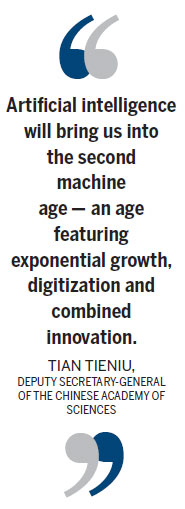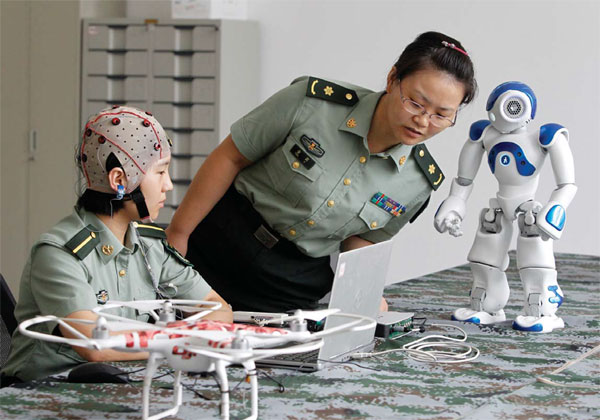Scientists develop exoskeletons

Iron Man suit in movie may look cooler than real-life version
In the Iron Man movies, businessman Tony Stark uses a robotic suit that gives him inexhaustible power to fight bad guys. In reality, the suit used is so heavy and unwieldy that actor Don Cheadle, who donned the costume in Iron Man 3, complained that it was "not cool at all" to play a superhero.
Scientists in Jiangsu province say they have developed a flexible and controllable "suit" that moves as nimbly as a mind controls the limbs.
| Two researchers at the PLA Information Engineering University test how to control robots with the "mind". Shen Xiang / For China Daily |
The Institute of Advanced Manufacturing Technology in Changzhou has completed an exoskeleton that can help the wearer climb a mountain carrying 30 kilograms of gear or punch through a wall without breaking a sweat.
The exoskeleton does not have the "cool" appearance of the Hollywood character, looking more like an iron skeleton with a bevy of sensors and electric wires. When worn these sensors catch every move's neuromuscular signals and respond with the right action.
"The potential application is wide," says Wang Yucheng, an assistant researcher at the institute, which is a unit of the Chinese Academy of Sciences' Hefei Institutes of Physical Science and focuses on robotics and intelligent manufacturing.
At a Brain-Inspired Intelligence Forum in June, Tan Tieniu, deputy secretary-general of the Chinese Academy of Sciences, said, "Artificial intelligence will bring us into the second machine age - an age featuring exponential growth, digitization and combined innovation."
One of the uses of such an exoskeleton could be to increase the fighting capacity of a soldier. For example, the Robotics and Human Engineering Laboratory at the University of California, Berkley, has been researching exoskeletons since early 2000 and has developed a range of products for military use.
The Human Universal Load Carrier can carry up to 90 kilograms while the wearer feels no weight, while the ExoHiker can enable the wearer to carry a 70-kg load and walk for 21 hours.
Besides military uses, superman abilities are also desired in emergency situations such as fire-fighting and earthquake rescues. "If a firefighter runs into a burning building wearing an exoskeleton, he or she can carry out two or more unconscious people, instead of carrying out one and heading into the danger again," Wang says.
Exoskeletons could also help some disabled people to walk or make movements, such as kicking a ball.

At the opening ceremony of the 2014 FIFA World Cup in Brazil, 29-year-old paraplegic Juliano Pinto kicked a soccer ball to start the games with the help of a mind-controlled exoskeleton.
"The mind-controlled exoskeleton, with an electrode cap, like the one used during the World Cup opening ceremony, reacts faster than neuromuscular-sensation exoskeletons like ours," Wang says.
When a person wants to make a movement, the electrode cap reads the change of his or her brain wave and makes the movement almost simultaneously, he explains. Neuromuscular sensors can only feel a body's movement when the action starts, so they react slower.
Scientists at the Chinese Academy of Sciences are collaborating with the National University of Defense Technology to develop mind-control exoskeletons. The technology has been tried on intelligent cars that can start, stop, make turns and drive at 5 to 10 kilometers per hour under mind control.
Mind-controlled machines are nothing new in the neuroscience field. Research on brain-computer interfaces began at the University of California, Los Angeles, in the 1970s. In 1998, researchers at Emory University in Atlanta implanted a device on a patient with locked-in syndrome - a condition the limits movement to only the eyes - that helped him move a computer cursor.
Researchers at Brown University and the University of Pittsburgh Medical Center also succeeded in enabling brain-controlled robotic prosthetic limbs on paralyzed patients in 2012.
As successes mount, governments are pouring more money into the technology.
In April 2013, US President Barack Obama announced the BRAIN Initiative, or Brain Research through Advancing Innovative Neurotechnologies, with a $100 million (87 million euros) budget to map the human brain. The European Union's Horizon 2020, the biggest EU research and innovation program, also targets brain research.
China included the brain and cognitive science as one of the eight research fields in the national long-term science and technology development plan through to 2020. Experts disclosed this year that the Chinese government would publish the country's brain project shortly.
"Research into brain-inspired intelligence has been included in the development strategies of major developed countries. China should boost the development of AI to seize the commanding heights of the new round of technological revolution," Tan says.
While people can use their minds to control some external devices, machines do not yet understand human thoughts, says Yang Zhi, a researcher in cognitive neuroscience at the Chinese Academy of Sciences' Institute of Psychology.
"Some of the mind-control technologies are actually using the reactions of people's brain activity - such as neuromuscular signals and movement of eyeballs - to control the external devices, while we still understand little about what kind of thoughts people may hold in their mind when they have a certain kind of brain activity and the corresponded reactions," he says.
Yang and his team have been studying that relation by analyzing a database that contains more than 5,000 brain magnetic resonance imaging scans relevant to people's emotions and thoughts.
Recently the team found that activities of certain brain regions are related to people's answers to yes-or-no questions. "For example, if I ask you if one minute equals 100 seconds, a certain region in your brain will be active, so that I will learn what your real idea is no matter what you say to me," Yang explains.
The technology has been used to test the brain activity of patients in a vegetative state to detect their responses to questions like: Can you feel the pain?
Connecting thought to corresponding brain activity is key to expanding the application of mind control, Yang says.
chengyingqi@chinadaily.com.cn
(China Daily European Weekly 08/28/2015 page26)
Today's Top News
- Japan tempting fate if it interferes in the situation of Taiwan Strait
- Stable trade ties benefit China, US
- Experts advocate increasing scope of BRI to include soft power sectors
- New engine powers cargo drone expansion
- China to boost green industry cooperation
- Manufacturing PMI rises in November































